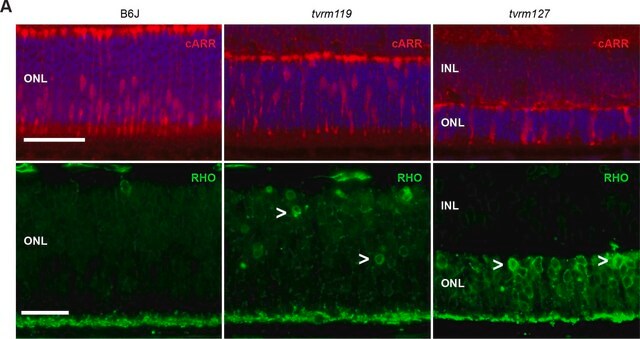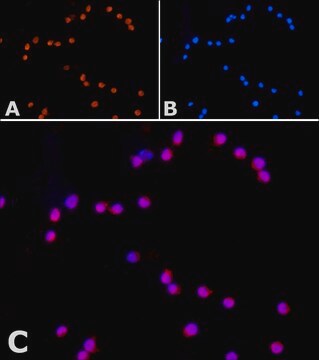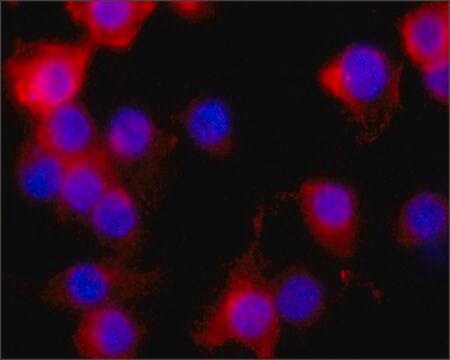추천 제품
생물학적 소스
mouse
Quality Level
항체 형태
purified antibody
항체 생산 유형
primary antibodies
클론
1-146, monoclonal
종 반응성
human, rat
종 반응성(상동성에 의해 예측)
mouse
기술
immunohistochemistry: suitable
immunoprecipitation (IP): suitable
western blot: suitable
동형
IgG1κ
NCBI 수납 번호
UniProt 수납 번호
배송 상태
wet ice
타겟 번역 후 변형
unmodified
유전자 정보
human ... STX3(6809)
rat ... Stx3(81802)
일반 설명
Syntaxin-3, also known as Stx3, is a member of the SNARE family which are complexes involved in membrane fusion. Syntaxin-3 is expressed in epithelial cells and is found apically in MDCK and Caco-2 cells (1).
특이성
This antibody recognizes Syntaxin-3.
면역원
GST-tagged recombinant protein corresponding to residues contained within rat Syntaxin-3.
애플리케이션
Detect Syntaxin-3 using this Anti-Syntaxin-3 Antibody, clone 1-146 validated for use in WB, IP, IH.
Research Category
Neuroscience
Neuroscience
Research Sub Category
Synapse & Synaptic Biology
Synapse & Synaptic Biology
품질
Evaluated by Western Blot in rat brain tissue lysate.
Western Blot Analysis: : 0.5 µg/mL dilution of this antibody detected Syntaxin-3 on 15 µg of rat brain tissue lysate.
Western Blot Analysis: : 0.5 µg/mL dilution of this antibody detected Syntaxin-3 on 15 µg of rat brain tissue lysate.
표적 설명
Approx. 33 kDa
물리적 형태
Format: Purified
Protein G Purified
Purified mouse monoclonal in buffer containing 0.1 M Tris-glycine, pH 7.4, 150 mM NaCl with 0.05% NaN3.
저장 및 안정성
Maintain refrigerated at 2-8°C for 1 year from date of receipt.
분석 메모
Control
Rat brain tissue lysate
Rat brain tissue lysate
기타 정보
Concentration: Please refer to the Certificate of Analysis for the lot-specific concentration.
면책조항
Unless otherwise stated in our catalog or other company documentation accompanying the product(s), our products are intended for research use only and are not to be used for any other purpose, which includes but is not limited to, unauthorized commercial uses, in vitro diagnostic uses, ex vivo or in vivo therapeutic uses or any type of consumption or application to humans or animals.
적합한 제품을 찾을 수 없으신가요?
당사의 제품 선택기 도구.을(를) 시도해 보세요.
Storage Class Code
12 - Non Combustible Liquids
WGK
WGK 1
Flash Point (°F)
Not applicable
Flash Point (°C)
Not applicable
시험 성적서(COA)
제품의 로트/배치 번호를 입력하여 시험 성적서(COA)을 검색하십시오. 로트 및 배치 번호는 제품 라벨에 있는 ‘로트’ 또는 ‘배치’라는 용어 뒤에서 찾을 수 있습니다.
Daniëlle Rianne José Verboogen et al.
eLife, 6 (2017-05-20)
SNARE proteins play a crucial role in intracellular trafficking by catalyzing membrane fusion, but assigning SNAREs to specific intracellular transport routes is challenging with current techniques. We developed a novel Förster resonance energy transfer-fluorescence lifetime imaging microscopy (FRET-FLIM)-based technique allowing
Adrian J Giovannone et al.
Molecular biology of the cell, 28(21), 2843-2853 (2017-08-18)
Syntaxin 3 (Stx3), a SNARE protein located and functioning at the apical plasma membrane of epithelial cells, is required for epithelial polarity. A fraction of Stx3 is localized to late endosomes/lysosomes, although how it traffics there and its function in
Hiroshi Gomi et al.
The journal of histochemistry and cytochemistry : official journal of the Histochemistry Society, 65(11), 637-653 (2017-09-16)
The comparative structure and expression of salivary components and vesicular transport proteins in the canine major salivary glands were investigated. Histochemical analysis revealed that the morphology of the five major salivary glands-parotid, submandibular, polystomatic sublingual, monostomatic sublingual, and zygomatic glands-was
Poppy Datta et al.
The Journal of biological chemistry, 294(50), 19119-19136 (2019-11-07)
Mutations in the centrosomal protein 290 (CEP290) gene cause various ciliopathies involving retinal degeneration. CEP290 proteins localize to the ciliary transition zone and are thought to act as a gatekeeper that controls ciliary protein trafficking. However, precise roles of CEP290
Poppy Datta et al.
PloS one, 16(5), e0246358-e0246358 (2021-05-08)
Nephrocystin (NPHP1) is a ciliary transition zone protein and its ablation causes nephronophthisis (NPHP) with partially penetrant retinal dystrophy. However, the precise requirements of NPHP1 in photoreceptors are not well understood. Here, we characterize retinal degeneration in a mouse model
자사의 과학자팀은 생명 과학, 재료 과학, 화학 합성, 크로마토그래피, 분석 및 기타 많은 영역을 포함한 모든 과학 분야에 경험이 있습니다..
고객지원팀으로 연락바랍니다.







